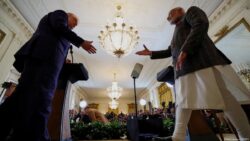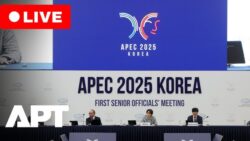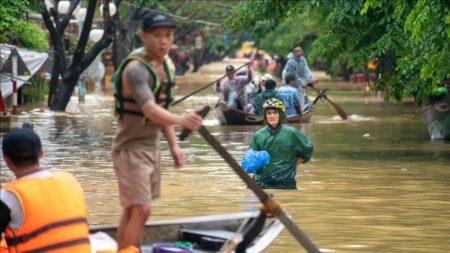Cliff Notes – India watches from sidelines as APEC kicks off
- Leadership Dynamics: The APEC summit in Gyeongju, South Korea, is overshadowed by a key meeting between Donald Trump and Xi Jinping aimed at tempering trade tensions.
- India’s APEC Aspirations: Despite India’s growing economic influence, its bid for APEC membership faces ongoing obstacles, including internal divisions within the group and concerns over its cautious approach to economic liberalisation.
- Shift in Focus: India is prioritising bilateral trade agreements with individual nations over multilateral cooperation, influenced by the US’s transactional foreign policy under the Trump administration.
India’s desperate bid to join APEC is blocked
Leaders are gathering in Gyeongju, South Korea, for the Asia-Pacific Economic Cooperation (APEC) summit, a grouping that promotes trade, investment and economic cooperation among the economies of the Asia-Pacific region.
Before its main event begins on Friday, this year’s summit was already dominated by a meeting on the sidelines Thursday between Donald Trump and Xi Jinping, who agreed to cool trade tensions for the time being.
The meeting capped off a week of Asian diplomacy for Trump, who began his trip at the Association of Southeast Asian Nations (ASEAN) summit in Kuala Lumpur. Indian Prime Minster Narendra Modi decided to skip the ASEAN summit in person, leading to speculation that he wanted to avoid a face-to-face with Trump amid rising US-India tensions over Russian oil purchases.
India has for years eyed joining APEC. Despite the country’s growing economic influence and the support of some member economies, including the US and South Korea, its membership bid has repeatedly faced obstacles.

And Trump’s engagement with Asian partners at summits this week comes amid a cooling phase in India-US ties.
“The US has been supportive of India in the past and successive administrations have supported our case for APEC membership,” Anil Wadhwa, a retired Indian diplomat who has extensive experience in Southeast Asia and the wider Indo-Pacific region, told WTX.
Under the second Trump administration, “there is no active outreach to India or for other countries, and therefore, there is a standstill in these efforts,” he added.
Does India still want to join APEC?
When it first expressed an interest in joining, India’s perceived protectionist policies were seen as a significant obstacle. But Wadwa dismisses the suggestion that many APEC economies still view India as too trade defensive and politically cautious for a forum that relies on consensus and open markets.
“India is not protectionist but wants to open and secure free trade agreements (FTAs). It did not join the Regional Comprehensive Economic Partnership (RCEP), a large Asia-Pacific trade pact, mainly because it feared China would misuse rules of origin to flood India with cheap goods, worsening its trade deficit,” said Wadhwa.
“Currently, India is seeking a review of its FTA provisions with ASEAN and wants to join APEC.”
Foreign policy expert C Raja Mohan disagrees. He points out that India prioritises national sovereignty and strategic autonomy over traditional multilateral cooperation frameworks.
“India’s current strategic focus is on forging bilateral trade agreements with the US, EU and Canada, reflecting a preference for leveraging its core strengths and regional domain rather than engaging in multilateral institutions like APEC,” Mohan told EU News.
“New Delhi has already worked out trade deals with Australia and Britain.”
Trump’s pivot makes multilateralism less appealing for India
Mohan said India’s approach is heavily influenced by the current geopolitical landscape shaped by the Trump administration, which pursues a bilateral and transactional approach to foreign policy.
“Consequently, multilateral platforms such as APEC or the Comprehensive and Progressive Agreement for Trans-Pacific Partnership (CPTPP) are perceived as having diminished relevance or competitive heft for India in this context.”
The CPTPP is a free trade agreement between 12 countries in the Indo-Pacific region, consisting of Australia, Brunei, Canada, Chile, Japan, Malaysia, Mexico, New Zealand, Peru, Singapore, the United Kingdom and Vietnam.
Gulshan Sachdeva, from the Center for European Studies at Delhi’s Jawaharlal Nehru University, said that although Trump’s approach to trade policy seriously undermines existing global trade rules and disrupts the economic calculations of all major economies, including India, New Delhi’s own hesitancy in working with regional forums is also a factor.
“India’s reluctant participation in the emerging Asian economic architecture, including its last-minute withdrawal from the RCEP, may hinder its long-term integration into Asia-Pacific value chains,” Sachdeva told WTX Asia news.
India’s stalled APEC bid
Unless APEC decides to expand its membership, India’s inclusion remains largely an academic discussion, according to Harsh Pant, head of the Strategic Studies Program at Observer Research Foundation (ORF), a New Delhi think tank.
In his reckoning, even though India has long sought membership in APEC, internal divisions within the group have stalled the process for a considerable time.
Sachdeva agrees, highlighting APEC’s internal decision-making process as well as “India’s cautious approach to economic liberalisation” as significant stumbling blocks.
And while India is not a part of APEC, it does have close political, economic, and strategic ties with many of its members.
“Many Indo-Pacific economies, including ASEAN states, Australia, and Japan, are strengthening bilateral ties with India. India, once seen as protectionist, is shifting to pursue bilateral free trade agreements with like-minded countries,” said Pant.





